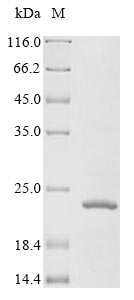Advance your research in developmental biology with our high-quality Recombinant Human IGF1R protein, an essential tyrosine kinase receptor involved in the regulation of cell growth, differentiation, and metabolism. As the receptor for insulin-like growth factor 1 (IGF-1), it is pivotal in the mediation of IGF-1 signaling and has been associated with numerous physiological processes and pathological conditions, including cancer and diabetes.
Our Recombinant Human IGF1R protein encompasses a partial protein sequence (763-931 amino acids) and is expressed in mammalian cell systems, ensuring proper folding and post-translational modifications. The N-terminal 10xHis-tag enables efficient protein purification and detection, while its purity, greater than 85% as determined by SDS-PAGE, ensures accurate and reproducible results in your experiments. Available in both liquid and lyophilized powder forms, our Recombinant Human IGF1R protein is adaptable to meet the demands of your research endeavors.






